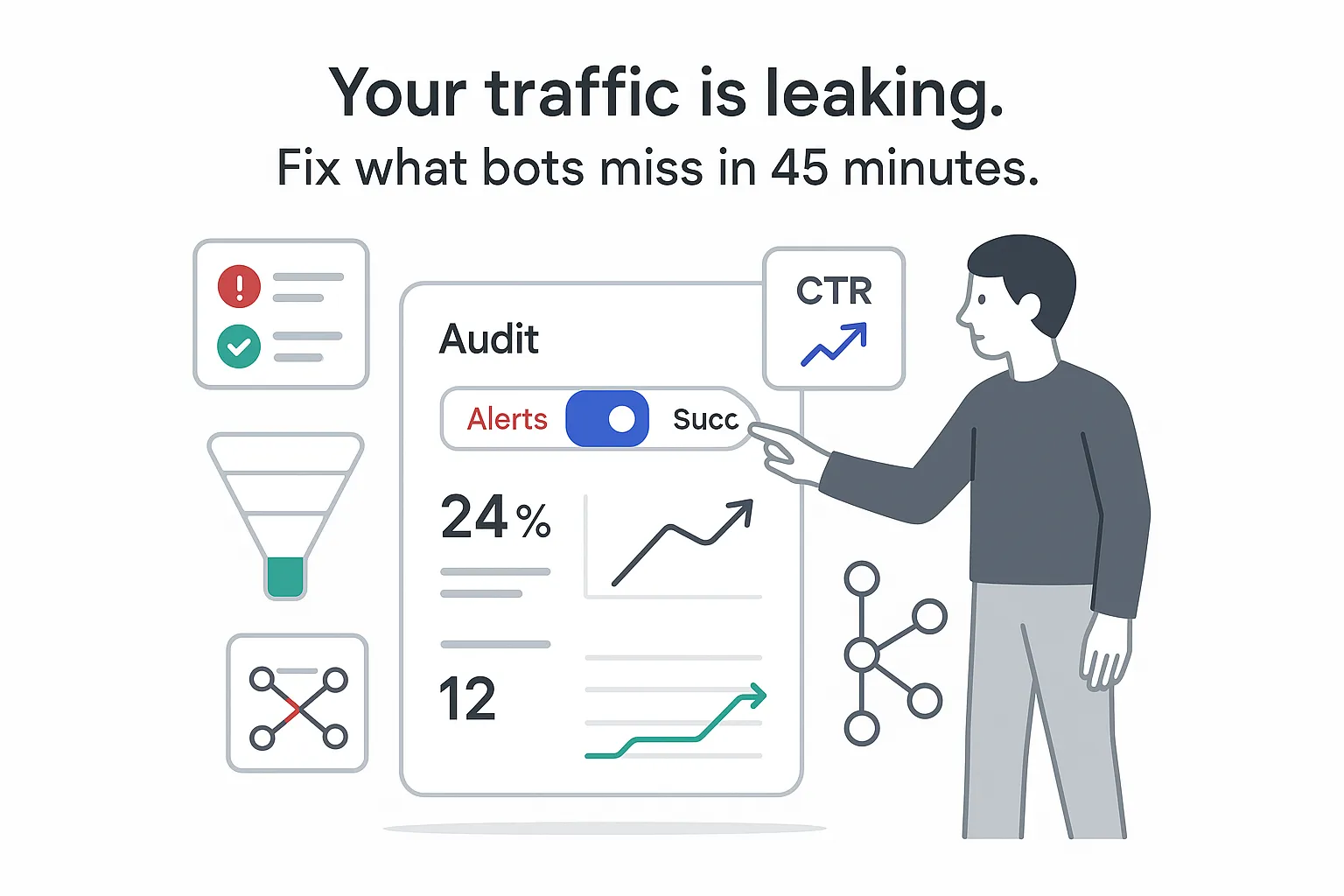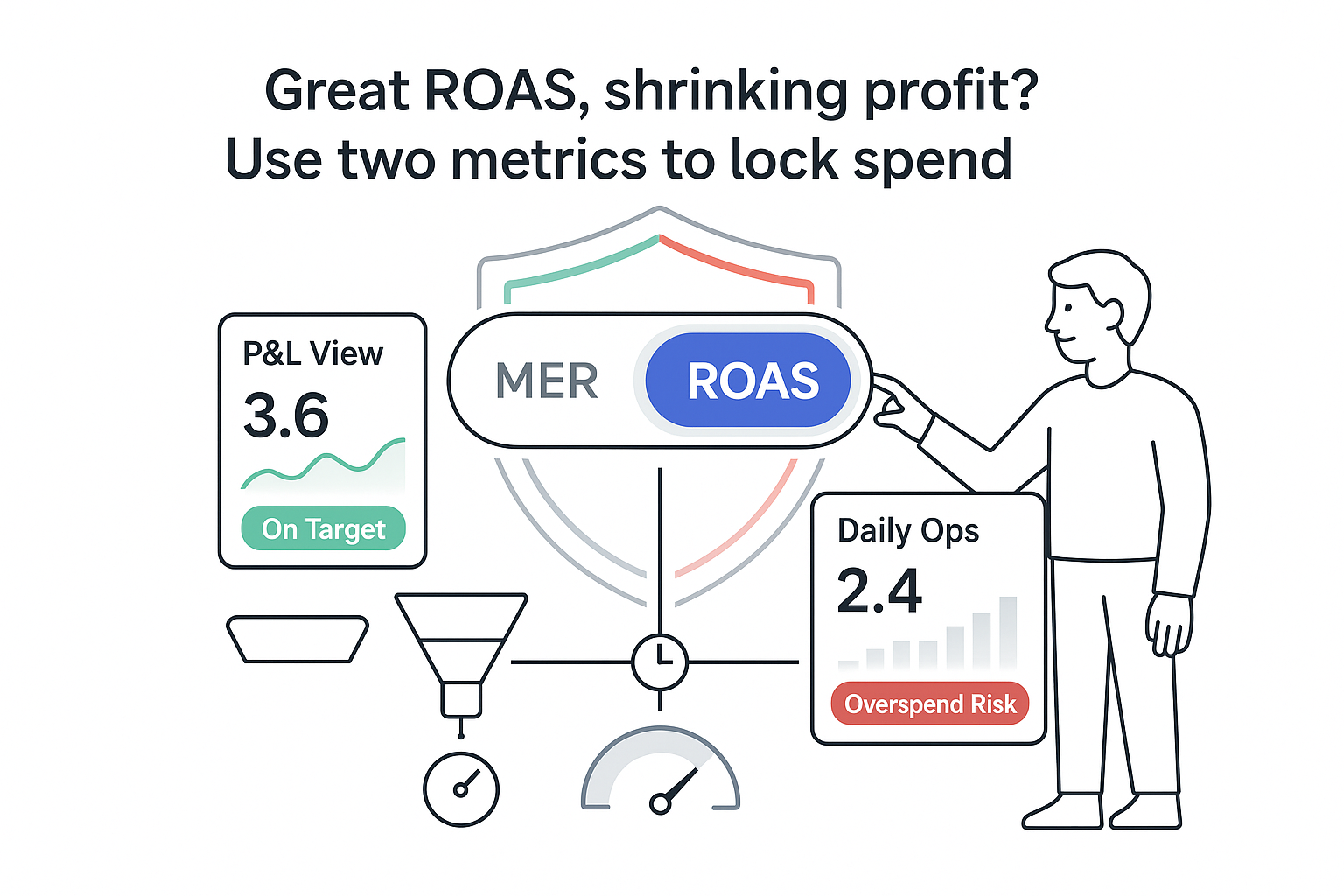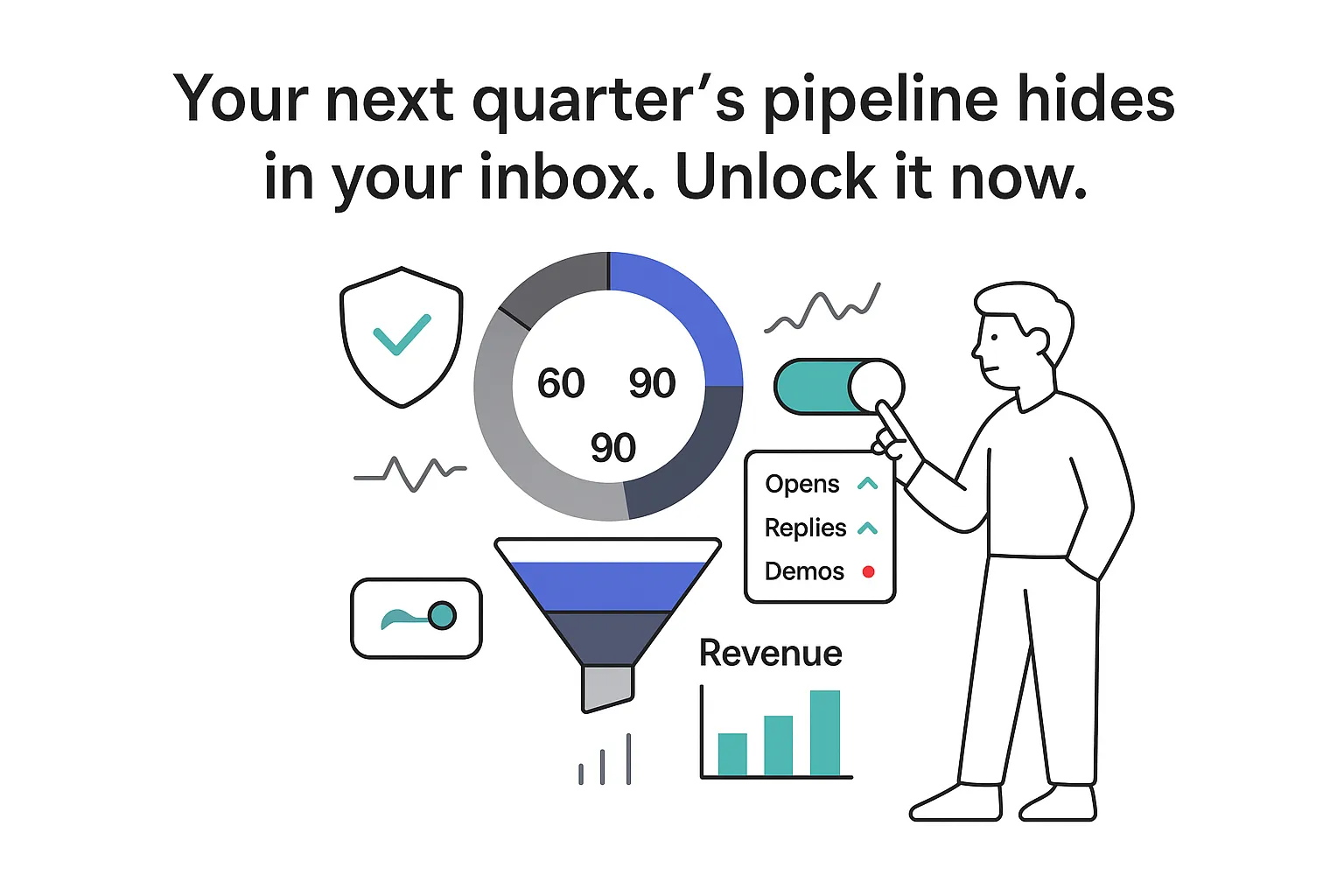I want fast visibility wins, fewer wasted dollars, and a partner-level sense of accountability without babysitting every task. This DIY SEO audit is how I get exactly that. It’s a non-technical, time-boxed sweep that spots what’s holding back a B2B pipeline and shows where to get quick gains while setting up for steady growth. I set a timer for 30 to 60 minutes. By the end, I know what to fix now, what to schedule next, and how the changes should pay off in qualified leads and lower acquisition costs.

DIY SEO audit
In a tight window, I focus on what moves rankings, clicks, and conversions for service-driven B2B sites. I keep it practical, not perfect. I start with free options and reserve budget for fixes that actually matter.
- Mini audit timer: 30 to 60 minutes total
- Outcomes: faster index coverage, cleaner crawl paths, better click-through rates, stronger pages, and fewer technical snags
- ROI angle: prioritize money pages, reclaim wasted crawl budget, and lift CTR on pages already near page one
7-step audit at a glance:
- 1) Indexing and crawlability 5-8 minutes
- 2) Technical SEO 7-10 minutes
- 3) On-page SEO 8-10 minutes
- 4) Content quality 7-10 minutes
- 5) Internal linking 4-6 minutes
- 6) Backlink profile 5 minutes
- 7) User experience signals 5-7 minutes
Indexing and crawlability
I spend 5-8 minutes here. If Google can’t find or index my pages, nothing else matters. I start with what drives revenue: services, industries, pricing, case studies, and key blog assets that support sales conversations.
What I do
- I run a quick site:domain.com search to spot-check what appears. It’s directional, not exhaustive, but it surfaces odd parameter pages or missing core pages fast.
- I open Google Search Console and check Pages (Indexing) for errors and excluded URLs. I scan reasons like Crawled - currently not indexed, Duplicate, or Soft 404.
- I validate robots.txt for accidental blocks. I confirm the XML sitemap exists, is linked in robots.txt, and is submitted in Search Console.
- I use URL Inspection on the top 5 money pages to confirm they’re indexable (no accidental noindex) and rendering properly.
Common blockers I fix first
- noindex applied to important pages
- Blocked paths in robots.txt
- Parameter or pagination URLs flooding the index (I use canonical tags and/or noindex where appropriate)
- Thin or duplicate pages outranking the intended target
I prioritize the highest-value pages. If a key service page is excluded, I address it immediately and request indexing in Search Console.
Technical SEO
I spend 7-10 minutes on speed, stability, and safety - factors that influence how visitors feel and how Google evaluates pages.
Tools I use briefly
- PageSpeed Insights for Core Web Vitals (CWV)
- Lighthouse in Chrome for a quick scan
- WebPageTest for a second opinion if time allows
What I look at
- Core Web Vitals (per Google’s thresholds): LCP under 2.5s, CLS under 0.1, INP under 200ms (INP replaced FID in 2024)
- Mobile readiness: responsive layout, legible text, tappable controls
- HTTPS across all pages
- Errors: 4xx/5xx and redirect chains that slow crawlers and users
Quick wins I queue
- Compress hero images and convert to next-gen formats like WebP
- Lazy-load images below the fold and defer non-critical scripts
- Add a CDN or tune caching to reduce repeat load times
- Fix broken links and flatten redirect chains to a single 301
Non-technical translation: I make the first screen load fast, reduce layout shifts, and remove speed bumps. If I fix only one thing today, I fix the hero image weight on top-revenue pages.
On-page SEO
I spend 8-10 minutes on under-the-hood messaging. Small tweaks to titles and meta descriptions can produce outsized clicks without new content.
Helpful checks
- One focus keyphrase per page, mapped to buyer intent (informational vs. commercial)
- Unique title tags written like mini ads; aim for clarity and keep under ~60 characters to avoid truncation
- Meta descriptions that promise value in plain language; target ~155 characters
- H1 present and aligned with the title theme
- Structured data where it helps: Organization on the homepage, Service on service pages, FAQ on Q&A sections, and Article/WebPage types where relevant
Fast wins I implement
- I rewrite titles and metas for the top 5 money pages, include the key phrase naturally, and speak to the outcome a buyer wants.
- I fix duplicate titles and missing metas flagged by a quick crawl.
Example rewrite:
- Before: Services | Company Name
- After: B2B IT Support for Mid-Market Teams | 24-Hour Response
Content quality
I spend 7-10 minutes making sure strong content isn’t competing with itself and that it answers the next logical buyer questions.
What I do
- I map queries to pages in Search Console. If multiple pages rank for the same term, that’s cannibalization. I decide which page should own the topic.
- I identify thin or duplicate pages. If two posts chase the same keyword, I merge them into one stronger piece with redirects.
- I compare key pages to the top results. I note missing sections common to B2B decisions: pricing signals, integration details, timelines, process steps, and proof like case study outcomes.
Quick fixes for B2B service pages
- I consolidate overlapping blogs into one authoritative guide with clear sections and anchor links.
- I add missing proof: brief case study snippets, light pricing ranges, process steps, or comparisons.
- I refresh stats, screenshots, and examples so they’re within the last 12 months.
I keep intent central. A buyer searching for managed accounting services expects cost ranges, onboarding steps, tooling, typical outcomes, and proof. I give them that in straightforward language.
Internal linking
I spend 4-6 minutes here because it’s the fastest structural win. Internal links pass context and authority, helping both Google and visitors find the right pages.
What I check
- Orphaned URLs and money pages with few internal links (via a quick crawl or Search Console Links report)
- Logical places to add links from the homepage, service hubs, pillar content, and case studies
- Descriptive anchor text that matches the destination topic (not “click here”)
Quick win habit
- I add 3-5 internal links to each revenue-focused page from related content. I revisit top blogs with traffic and link to service pages.
Backlink profile
I spend 5 minutes scanning link quality. Links from credible, relevant sites still matter for trust and ranking. I don’t need hundreds - just clean, relevant ones - and I reclaim what I already earned.
What I scan
- Top linking domains: relevance and reputation
- Anchor text profile: mostly branded and natural, not spammy exact match
- Recent links gained or lost
Quick wins I prioritize
- Reclaim brand mentions by asking for a link where my company name appears without one.
- Fix 404s with redirects so old links point to live pages.
- Add or update partner and association directory listings.
If I find suspicious links, I note them. Many can be ignored if the overall profile is healthy. I use Google’s Disavow only with care.
User experience signals
I spend 5-7 minutes aligning UX with performance. If visitors land and bounce, rankings and pipeline suffer. I pair this with Core Web Vitals for a fuller picture.
What I check
- Top landing pages with low engagement or high exit in GA4
- Mobile experiences that feel cramped or slow
- Above-the-fold clarity: can a visitor grasp the value prop in ~3 seconds?
Quick wins I make
- I tighten hero copy to name the audience, the problem, and the outcome.
- I compress or swap the hero image and delay non-critical scripts.
- I remove intrusive mobile pop-ups or delay them.
- I add a short social proof strip (client logos or a succinct testimonial) below the hero.
I keep tracking simple and visible. A lightweight dashboard with Search Console impressions, clicks, and average position alongside GA4 engagement and a Core Web Vitals pass rate keeps priorities clear.
Setting SEO goals: I tie goals to pipeline. I aim for more indexed money pages, higher CWV pass rates, better CTR on pages in positions 4-10, growth in top-10 keywords for service terms, and conversions like demo requests or discovery calls.
Frequently asked questions
I keep answers short and outcome-focused. Where it’s helpful, I add FAQPage schema so search engines can read this section cleanly.
What are the common mistakes to avoid during a DIY SEO audit?
- Skipping index checks and assuming pages are in Google
- Chasing vanity keywords that never convert to pipeline
- Ignoring Core Web Vitals while wondering why bounce is high
- Reusing the same title across multiple pages
- Leaving money pages orphaned with zero internal links
- Not measuring before and after, so ROI is invisible
- Treating blog posts as a silo instead of linking them to services
How often should I run this DIY SEO audit?
I do a monthly 30-60 minute sweep to catch index issues, CTR drops, and new errors. I add a quarterly deeper review tied to releases, new content, or product shifts. After major changes or a migration, I audit immediately.
Can DIY replace professional SEO services?
DIY is ideal for triage, quick wins, and momentum. An experienced team adds compounding growth with content strategy, authority building, structured data at scale, and advanced technical work like log analysis or complex architectures. I use DIY for speed and bring in depth when needed.
What role does content quality play in an audit?
Content quality drives lead quality. Strong pages match intent, show real experience, and answer the next three buyer questions (proof, pricing signals, process). Better content improves engagement, rankings, and sales enablement in one move.
How do I measure success after this audit?
I benchmark first, then track:
- Indexed coverage for money pages
- CWV pass rates across key templates
- CTR improvements on pages in positions 4-10
- Growth in top-10 keywords for service terms
- Conversions tied to organic sessions (demo requests, discovery calls)
What’s the importance of backlinks in a DIY audit?
Backlinks act as trust signals. A handful of clean, relevant links can influence competitive terms. Fast wins typically come from reclaiming brand mentions, fixing broken link paths with redirects, and updating partner or association listings.
Resources mentioned
That’s my compact, CEO-friendly DIY SEO audit. It keeps decisions simple, directs effort toward revenue pages, and sets a cadence I can maintain. I spot what needs fixing in minutes, then spend time where ROI compounds: better indexing, faster pages, cleaner metadata, stronger content, tight internal linking, credible links, and a user experience that makes the next step obvious.







.svg)